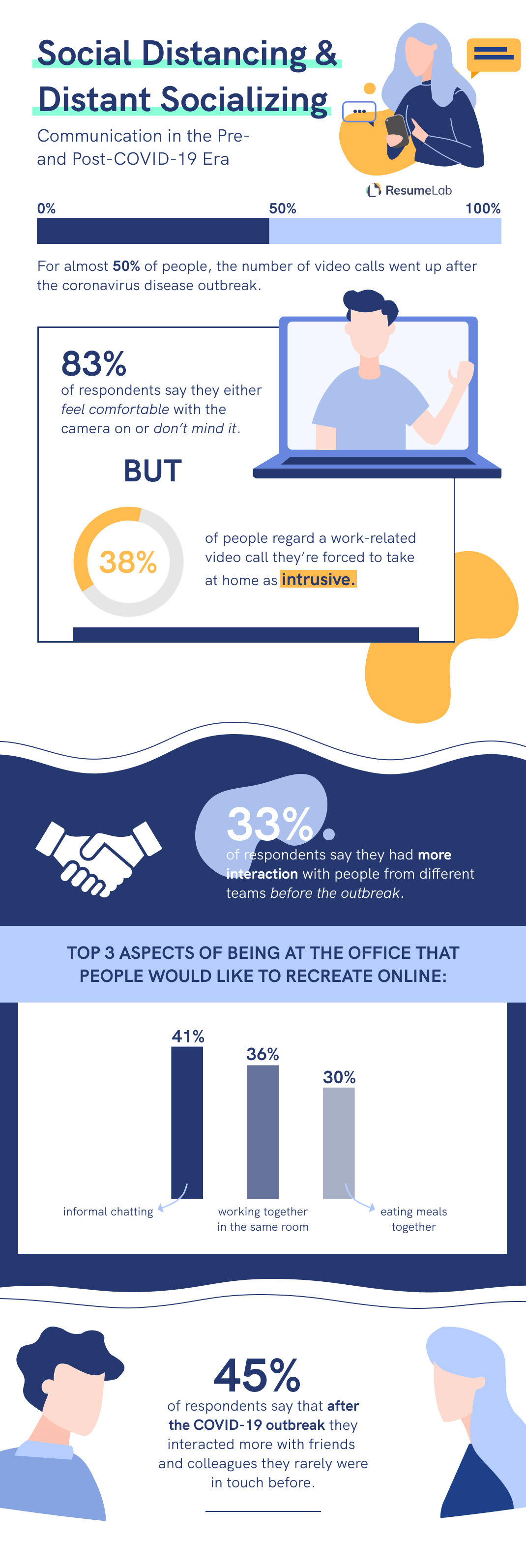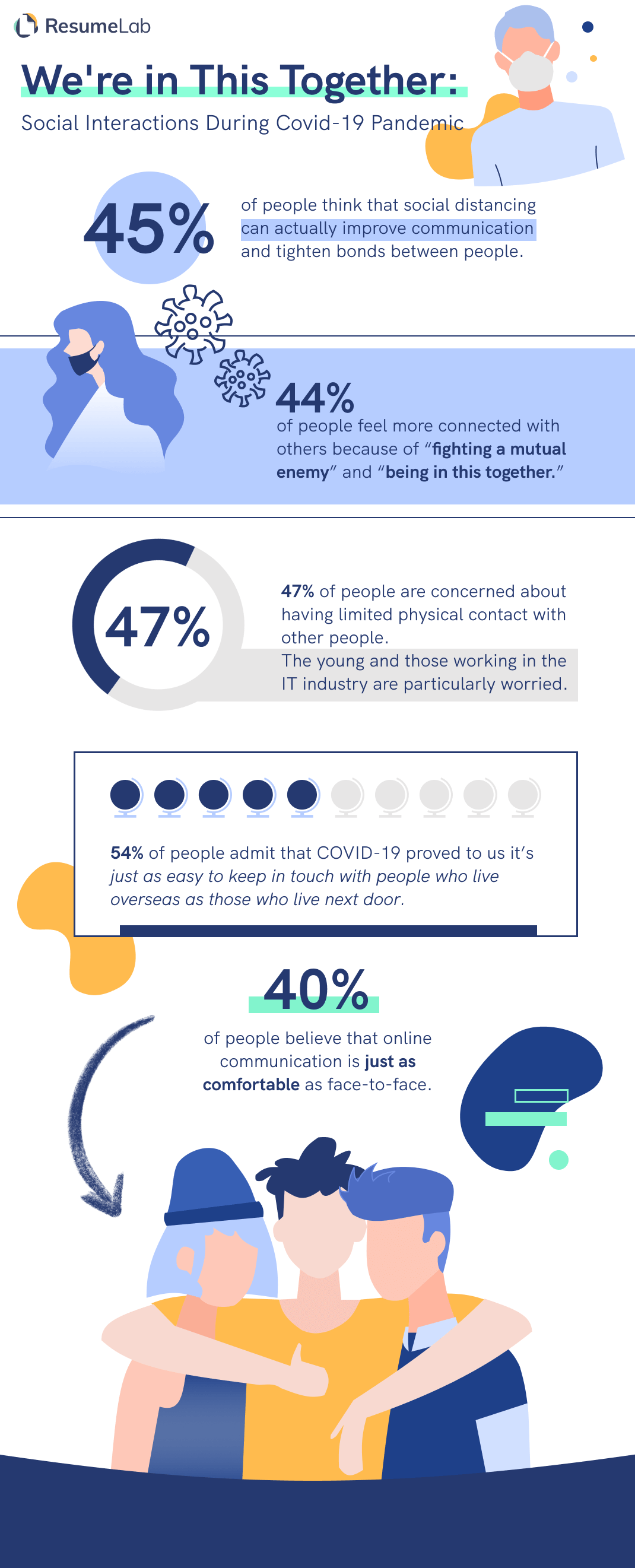![Social Distancing or Distant Socialising? [2020 Study]](https://cdn-images.resumelab.com/pages/social_distancing_hero_uk.jpg)
- Home
- Career Advice
- Social Distancing or Distant Socialising? [2020 Study]
Social Distancing or Distant Socialising? [2020 Study]
From now on, we’ll be looking at the world in terms of how it looked before and after the COVID-19 pandemic. Over 1,000 Americans told us how the way they communicate has changed.
In the 1980s, the Police sang Don’t Stand So Close to Me, and it was a hit that lots of people sang along to. In the early 2020s, the same message from the police won’t make anyone sing along but rather comply and take a step back for obvious reasons.
Times have changed, that’s a fact. But we’re all human, and we long for real-life contact and interaction with other people. Or do we? Can video conferencing replace face-to-face meetings entirely? Do we really crave for more “IRL” interactions in this new COVID reality?
We asked 1,047 Americans to share their opinions on and experiences with social distancing and distant socialising. That’s what they told us.

Before and After
Watershed moments introduce certain demarcation lines—we like to look at the world before and after them. The coronavirus outbreak will surely come down in history as one of such moments and we’ll be looking at what our lives looked like before it, and how they changed afterward.
This is exactly why we spun our study around questions probing the differences between pre- and post-COVID-19 reality. First off, we wanted to learn whether or not the number of video calls they participated in really grew.
In short: yes, it did.
For the other half, it either didn’t change (14%) or was actually higher before the outbreak (36%).
The largest increase—with over 60% of respondents admitting that video connexions were on the rise—was visible in companies employing between 500 and 1,000 people.
Interestingly, the sector where video calls were more common before the COVID-19 outbreak was manufacturing. However, with so many production plants being temporarily or permanently closed, it’s no wonder that the number of video calls in this particular industry actually dropped.
How You Like Me Now?
The truth is that video calls aren’t a new thing, are they? All the tools we’re using now were just as readily available before the outbreak. It’s only that a lot of us started using them on a regular basis. Now, since we use the video conferencing technology more often, have we become more fond of it?
Well, not really.
An overwhelming majority of our respondents (60%) admitted that their opinion about talking to people on screen hasn’t changed at all.
Interestingly, it’s the manufacturing sector where the largest percentage of respondents liked video conferencing better before COVID-19.
We also wanted to probe into how comfortable people are with video on.
The results showed us that video conferencing seems to have already become a norm with a total of 83% of respondents saying they either felt comfortable (53%) or didn’t mind the camera (30%).
Well, maybe the 17% who felt discomfort were stuck in meetings with people sitting too close to their webcams, as a recent University of California Santa Barbara study suggests.
And one more thing—
Turning a camera on in your laptop lets others peer into the privacy of your home (unless of course, you’re using one of those virtual backgrounds). So, do the video calls you’re forced to take at home feel like an intrusion into your privacy?
Well, this is where people seem to be more willing to draw a line. To almost 38% of respondents, a work-related video call that you’re forced to take at home does feel intrusive. It’s worth noting that younger generations (Gen Z and Millennials) are more likely to feel this way than older generations (people aged 60+). While about 40% of young respondents feel like video calls from work invade their privacy, less than 25% of older respondents believe that to be true.
Maybe the young are simply more aware of the existence of such Twitter profiles as RoomRater or similar.
Hello, Is It Me You’re Looking For?
Being at the office does have advantages. One of them is that we can simply walk down the corridor and ask a quick question to a colleague from a different team. With the advent of video conferencing, this can obviously be replaced with a quick call.
But do we take advantage of this and catch our colleagues from different teams for quick calls or do we interact less with them now?
Almost 43% of our respondents don’t see much of a difference. This could be a good sign indicating that video conferencing works as it should and doesn’t disrupt communication across different teams.
But the thing is that almost 33% of respondents say they had more interaction with people on different teams before the outbreak. So maybe, after all, video conferencing is more of a mixed blessing than a clear winner.

Coffee and TV
Modern offices are places that are supposed to foster creativity and casual interactions between employees. In the context of video calls, such workplace interactions can be replaced with an offhand call. Or can they?
We asked how the COVID-19 outbreak affected the number of informal meetings our respondents had with their colleagues. We were expecting the number to be significantly lower after the outbreak.
It turned out we were mistaken.
The remaining 40% admitted they participated in more informal meetings with colleagues before the outbreak.
Interestingly, the largest percentage of respondents who met more informally before COVID was in the education sector (46%). However, this isn’t that surprising if you think of all the teachers bouncing ideas off each other during the breaks.
Finally—
We asked our respondents which aspects of being at the office they’d like to try and recreate using online conferencing tools.
Informal chatting ranked one with over 41% of respondents expressing their willingness to do so, followed by working together in the same room (36%), and eating meals together (30%).
Our respondents were also given an opportunity to tell us what it was they missed most about working from the office. The answers that recurred most were about simply being around other people.
Which Aspects of Working at the Office Do You Miss Most?
- Asking for help
- Being around everyone
- Checking my mail, getting coffee made by others, interaction in the hallways, dressing up a little. Just the professionalism
- Commute
- Getting out of the house
- Happiness
- Having complete access to resources
- Just wandering the office talking to folks
- Nothing, I hate being around people.
- Seeing everyone every day
- Socialising in person and water cooler talk
- The funny moments with co-workers
- Two monitors
Ch-Check It Out
It’s common knowledge that we share a lot of things online. Studies show that we do it for various reasons. We were curious to see whether or not the necessity to spend even more time in front of the computer screen changed our sharing habits. In other words, do we now share more links to interesting online finds than before COVID?
Not necessarily.
Also, as we’re getting bored scrolling through social media updates, some of us may feel the urge to reach out to people we haven’t contacted for some time. That’s what we explored as well—
Almost half of the respondents (45%) said they did interact more with friends and colleagues they rarely were in touch before.
But we didn’t end here and pushed things a little bit further with another question:
Can social distancing actually improve communication and tighten bonds between people?
The answers took us by surprise. As many as 45% of respondents admitted this was the case with almost half of the young singing off on this statement.
Such a sentiment may result from the fact that almost just as many of our respondents (44%) feel more connected with people around them because of “fighting a mutual enemy” and “being in this together.”
Human Touch
So, it seems like the age of digital communication is in bloom and despite the distance between us, we’re doing quite fine. But does it mean we’re all entirely unaffected by the fact that we need to keep away from each other?
Not really.
In terms of demographics, we noticed two groups whose members were particularly worried—the young (51%) and those working in the IT industry (57%).
While the former seemed like a group whose concern was rather predictable, the latter took us by surprise as this result undermines the stereotype of a socially awkward “IT guy.”
Come Out and Play
As we’ve seen so far, the paradox of social distancing is that it can bring people together while pulling them apart at the same time. The fact is that COVID-19 is the first pandemic in a world connected more than ever before. Back in the days of the Spanish flu, there was no way for people to know what was happening on the other side of the town as quickly as we’re now able to learn what’s happening on the other side of the globe.
Events of such magnitude make us look at what we have and can do from new perspectives. For example, 54% of our respondents admitted that COVID-19 proved to us it’s just as easy to keep in touch with people who live overseas as those who live next door. More than this, 40% of respondents believe that for all its limitations, online communication is just as comfortable as communicating face to face.
In addition, the bounds that limit us—such as the inability to have physical contact with others—are a great test for our creativity. This is visible in the numbers of respondents willing to participate in such virtual get-togethers as:
- Watching Netflix in sync with friends and discussing the movie afterward (48%)
- Having an online reunion with friends you haven’t connected with in years (47%)
- Participating in online fitness activities (43%)
- Attending online concerts (43%)
And here are some suggestions from respondents themselves:
- Whiteboard discussions
- Casual conversations
- Brainstorming sessions
- Coffee breaks
Conclusions
The coronavirus disease outbreak has changed the way we interact with each other. For about 50% of people the number of work-related video calls they participate in went up. And while video conferencing seems to have become the new communication norm, almost 40% perceive work-related video calls they’re forced to take at home as an intrusion into their privacy.
Despite the fact that social distancing has pulled us apart from each other physically, 54% of people say that COVID-19 showed us it’s just as easy to keep in touch with people who live overseas as those who live next door. In addition, 45% of people believe that such artificial distancing can actually tighten bonds between people as they feel “they’re in this together.”
Finally, even though virtual communication may be as comfortable as face-to-face interactions, it’s unlikely to entirely replace the traditional way we communicate as almost half of the society is concerned about not having enough physical contact with others.
Methodology:
For this study, we collected answers from 1,047 respondents through Amazon's Mechanical Turk. Our sample’s average age was 38 with a standard deviation of 12 and consisted of 55.4% men and 44.6% women.
This self-report study probed into people’s attitudes towards social distancing, distant socialising, and communication patterns before and after the COVID-19 outbreak. Respondents were asked 22 questions, most of which were scale-based or multiple choice. As experience is subjective, we understand that some participants and their answers might have been affected by recency, attribution, or exaggeration bias. However, given the gender and age makeup of our sample, as well as the fact that the official labour force participation rate in July 2019 was 63%, the study can be generalised to the entire population.
Fair Use Statement:
Have you discovered something new about how people communicated before and after COVID-19? Feel free to share the results of our study with your audience for any non-commercial use. Just remember to include a link to this page so our contributors can earn credit for their hard work. Thank you!
Sources:
- https://www.researchandmarkets.com/reports/5013542/impact-of-covid-19-on-the-global-manufacturing
- https://www.prnewswire.com/news-releases/impact-of-covid-19-on-the-global-manufacturing-industry-2020-301042150.html
- https://www.businessinsider.com/large-face-zoom-video-call-trigger-fight-flight-response-researcher-2020-4?IR=T
- https://vhil.stanford.edu/publications/avatars-and-agents/interpersonal-distance-immersive-virtual-environments
- https://www.cnbc.com/2020/04/27/why-video-chat-during-covid-19-self-quarantine-causes-social-burnout.html
- https://www.washingtonpost.com/technology/2020/04/03/thousands-zoom-video-calls-left-exposed-open-web/
- https://www.iris.xyz/advisor-tools/5-major-advantages-of-employees-working-from-the-office/
- https://www.gensler.com/research-insight/blog/fostering-casual-collisions-and-creativity-in-a-virtual
- https://foundationinc.co/lab/psychology-sharing-content-online/
- https://www.bbc.com/worklife/article/20200421-why-zoom-video-chats-are-so-exhausting
